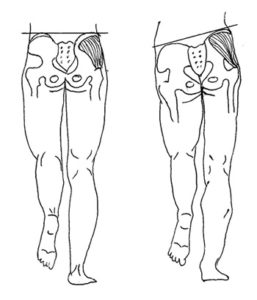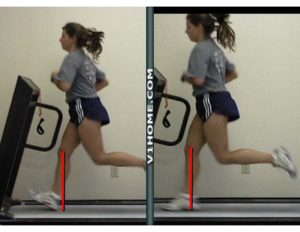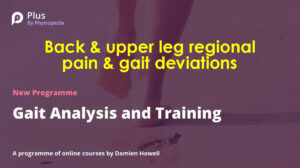Back Pain Dilemma – Keep on Walking

Walking is commonly recommended by many medical professional associations for management of back pain. Walking is purported to be beneficial counteracting the potential deleterious effects of bed rest, maintaining functional abilities, stimulating use of spinal core muscles, keeping the general benefits of aerobic exercise, and providing pain reduction effects.
Pain
Walking can provide relief to some individuals with back pain, and it can be painful to others. If you have back pain the dilemma is should you avoid walking or walk it out?

There are situations where the old saying “no pain no gain” may be applicable. The analogy has been made that acute low back pain is similar to common cold (upper respiratory infection). Resuming normal activity with an upper respiratory infection has little detrimental effect on the infection. If you have low back pain, walking maybe painful but it is unlikely to cause any further tissue damage.
If low back pain becomes chronic and persists over an extended period of time programs of “progressive desensitization” have proven to have successful outcomes for chronic musculoskeletal pain syndromes. Gradually alter the tolerance of pain. This approach can be described “exercise into pain”. Exercise is encouraged where pain is allowed. There are good pains and there a bad pains. The belief is pain may not be an indication of additional tissue damage. This is best done with care and under guidance of a health professional.
Gait Deviations Associated with Back Pain
Experts have identified gait deviations that occur when an individual is experiencing back pain. Gait deviations are variations from what is perceived as normal walking or running. We adapt or compensate for gait deviations making biomechanical changes in the way we walk or run. These adaptations often are at the subconscious level.
Individuals with back pain often walk or run with:
- slower speed, slower cadence, shorter steps
- excessive forward lean of the trunk
- stiffer movement between trunk and pelvis
- uncoordinated movement between trunk and pelvis
- excessive lordosis posture, excessive anterior pelvic tilt
- excessive pelvic drop or instability
- too much knee extension at foot strike
- flat lumbar spine (no lordosis curve) stooped posture slow shuffling gait
- asymmetrical alignment or scoliosis of the trunk
This is a chicken or egg situation, which came first the gait deviations or the pain?
Testable Working Hypothesis
If you have back pains then explore conscious efforts to eliminate gait deviations. Altering the gait deviations may decrease the pain. Altering gait deviations may increase back pain. Altering gait deviations may lead to other side effects; therefore it is wise to consult with PT to determine the best compensation.
This approach can be described as “exercise into pain”, where activity and exercise is encouraged where pain is allowed. There are good pains and there a bad pains.
If you have back pain are walking/running slowly with short steps then explore consciously taking longer steps and walking faster. Research has shown fast walking to have positive effects on recovery from back troubles (Nutter, P. 1988).
If you walk/run with excessive forward lean of trunk then consciously lifting chest up avoid walking with excessive forward lean. Investigate whether the forward lean is related to a physical impairment which would benefit from exercise to improve strength of spinal extensor muscles or joint mobilization to reduce restrictions limiting extension of the spine.
If you walk with a shuffling gait very little up and down motion of the center of mass, slow velocity and the low back is flat without lordosis then consciously engage the ankle muscles to push off and progress up and forward extending at the hip and taking longer steps.
If you walk tilted to one side then use a cane in the hand opposite the side of the pain, straighten up and walk without side tilt or trunk lean. Consciously swing arms symmetrically. Investigate whether the side lean or tilt is related to a physical impairment which would benefit from specific remedial exercises or joint mobilization to reduce restrictions limiting normal spinal alignment.
If you walk or run and feel and look stiff in the trunk with little rotation of the trunk from side to side then make a conscious effort to swing arms, rotate trunk, and take longer steps. Studies have shown a 10% reduction of spine loads from swinging arms when walking. This may be related to energy storage and return or passive mechanical gearing effects and reduction for need of muscle work. (Kubo 2006)
If your spine alignments when standing and walking is excessive lordosis then consciously employ your abdominal muscle perform posterior pelvic tilt while walking. Explore using supportive undergarment abdominal binder, take shorter steps, walk quiet, select shoes with low heel height. Walking with excessive lordosis anterior pelvic tilt likely increases the amount of shearing forces occurring in the low back.
If you walk/run with excessive pelvic drop (see image below on right) then make a conscious effort to engage and utilize the buttock muscles stabilizing the pelvis. Take shorter steps; avoid crossing the mid-line of the body slightly wider foot placement to widen the base of support. Explore using compression garments to support hip and pelvis.

If you walk/run with too much knee extension at foot strike then consciously take shorter steps, more steps per minute, walk softly. Image below on left the knee is in full extension on the right is conscious effort to shorten step and land softly.

Use shock absorbing shoes and shoe inserts, walk on softer surfaces. Compressive loads to lumbar spine are estimated to be 2.5 times body weight and increases with speed. Walking/running with too long a stride is known to increase impact forces which are transmitted to the back. Walking with hiking sticks has been shown to decrease forces into the lower extremity and spine and increase activity of abdominal muscles all of which is a positive effect on low back pain.
Dilemma
As you can see there is contradictory advice. As you can see there is a dilemma. In some situations it is good to walk or run into pain. In some situations it is bad to walk or run into pain. In some situations conscious efforts to length step can have a positive effect on back pain and at other times taking a longer step can contribute to back injury. In some situations walking slower can have a positive effect on back pain and at other times or situations walking faster can contribute to back pain. Back pain is a complex and multi-faceted problem. The above information is meant to provide an introduction to the concept identifying gait deviations walking or running that are associated with back pain. Then identifying conscious interventions to diminish or alleviate the symptoms. Testable working hypothesis are presented that you and your Physical Therapist can explore.
If you have back pain when walking or running work with your Physical Therapist and as Little Herman recorded the song (1964) “Gotta Keep on Walking
A on demand-video webinar exploring this topic is available at Plus by Physiopedia entitled “Back & upper leg regional pain & gait deviations”
Use this code – “Damien25” for a 30% discount to access this webinar as well as the more than 500 continuing education webinar courses available at Plus by Physiopedia. This is the link http://bit.ly/DAMIEN25 with the 30% discount code embedded
Damien Howell Physical Therapy – 804-647-9499 – Fax: 866-879-8591 At-Home, At Office, At Fitness Facility, or Online I come to you, I do home visits Damien@damienhowellpt.com

